Popular categories
Looking for a yarn?

100% Wool
from 2.15 € /50g
Order DROPS Needles & Hooks
Clicking the ORDER button will redirect you to Saules siulas website
The yarn cost is calculated from the pattern’s smallest size and the yarn’s cheapest product type. Looking for an even better price? You might find it on the DROPS Deals!
Mr. Sunshine
Knitted sweater for dog in DROPS Alaska. The piece is worked in rib. Sizes: XS - M.
DROPS Design: Pattern no x-478
Yarn group C or A + A
-------------------------------------------------------
Size: XS - S - M
Dog’s measurements:
Chest: approx. 28/32 – 40/44 – 48/52 cm
Back length: approx. 24 – 32 - 40 cm
Examples of dog breeds: XS = Chihuahua, S = Bichon Frisé, M = Cocker Spaniel
MATERIALS:
DROPS ALASKA from Garnstudio (belongs to yarn group C)
150-200-200 g colour 59, lemon
NEEDLES:
DROPS DOUBLE POINTED NEEDLES (size XS and S), CIRCULAR NEEDLE 40 cm (size M) 4 MM.
DROPS DOUBLE POINTED NEEDLES 3 MM for legs.
KNITTING TENSION:
19 stitches in width and 25 rows in height with stocking stitch = 10 x 10 cm.
NOTE: Needle size is only a guide. If you get too many stitches on 10 cm, change to a larger needle size. If you get too few stitches on 10 cm, change to a smaller needle size.
-------------------------------------------------------
Alternative Yarn – See how to change yarns here
Yarn Groups A to F – Use the same pattern and change the yarn here
Yarn usage using an alternative yarn – Use our yarn converter here
-------------------------------------------------------

100% Wool
from 2.15 € /50g
Order DROPS Needles & Hooks
Clicking the ORDER button will redirect you to Saules siulas website
The yarn cost is calculated from the pattern’s smallest size and the yarn’s cheapest product type. Looking for an even better price? You might find it on the DROPS Deals!
- English (UK/cm), Lithuania
- Česky
- Dansk
- Deutsch
- Eesti keel
- English (UK/cm)
- English (US/in)
- Español
- Français
- Íslenska
- Italiano
- Magyar
- Nederlands
- Norsk
- Polski
- Português
- Suomi
- Svenska
- English (UK/cm), Bulgaria
- English (UK/cm), Croatia
- English (UK/cm), Greece
- English (UK/cm), Latvia
- English (UK/cm), Romania
- English (UK/cm), Slovenia
- Česky, Slovakia
Pattern instructions
EXPLANATIONS FOR THE PATTERN:
-------------------------------------------------------
INCREASE TIP:
Increase 1 stitch in a purl section by picking up a loop between 2 stitches in the transition between purl and knit. Purl the loop twisted to avoid a hole. The increased stitch is subsequently purled.
-------------------------------------------------------
START THE PIECE HERE:
-------------------------------------------------------
JUMPER:
The piece is worked in the round with double pointed needles/circular needle from the neck and down towards the front legs. Then the piece is divided for the legs; the back and chest pieces are continued separately, back and forth. Then you work in the round down the body and finish by working back and forth towards the tail. The legs are worked in the round with double pointed needles. The whole jumper is worked in rib - it will look small, but is very stretchy.
Cast on 48-64-80 stitches with double pointed/circular needle size 4 mm and DROPS Alaska. Work rib (= knit 2 / purl 2) for 4-6-8 cm. Knit 1 round over all stitches. On the next round increase in every other purl section from purl 2 to purl 3 - read INCREASE TIP = 54-72-90 stitches. REMEMBER THE KNITTING TENSION! Continue rib until the piece measures 6-10-14 cm, now increase the remaining purl sections from purl 2 to purl 3 = 60-80-100 stitches. Continue with rib (= knit 2 / purl 3) until the piece measures 8-12-16 cm. Now divide for the front legs, work the next round in rib as follows: cast off the first 2 stitches, work the next 13-18-23 stitches and then place them on 1 thread (= mid under chest), cast off the next 2 stitches, work the remaining 43-58-73 stitches (= back piece).
BACK PIECE:
= 43-58-73 stitches. Continue to work rib back and forth over these stitches for 5-8-10 cm from the division (the piece measures a total of 13-20-26 cm). Place the stitches on 1 thread.
CHEST PIECE:
Place the 13-18-23 stitches from under the chest back on the needle and continue rib for 5-8-10 cm (the piece measures a total of 13-20-26 cm).
JUMPER:
Place all the stitches on the same needle and, at the same time, cast on 2 new stitches in each side between the chest and back pieces = 60-80-100 stitches. Continue rib as before. When the piece measures 20-28-35 cm cast off the middle 9-10-13 stitches mid under chest and continue working back and forth = 51-70-87 stitches. Continue to cast off at the beginning of each row as follows: Cast off 2 stitches 2 times and 1 stitch 2-5-7 times, 2 stitches 1 time and 3 stitches 1 time. Then cast off the remaining 29-42-55 stitches with knit over knit and purl over purl. The piece measures approx. 25-35-44 cm.
LEG:
Knit up 28-40-48 stitches with double pointed needles size 3 mm around the one leg opening. Work rib (= knit 2 / purl 2) for 4-6-7 cm, cast off with knit over knit and purl over purl. Repeat around the other leg opening.
What can you do with our patterns? You can share DROPS patterns online, using the pattern original picture, materials, name and number. But you are NOT ALLOWED to reproduce the complete pattern digitally in any way. Yarn stores are welcome to use the DROPS pattern database to promote the sale of our assortment. You can print out our patterns, make as many copies as you’d like. The only thing we ask is that you don't make any changes / additions to the original printed document. And that the patterns according to the DROPS philosophy are given out to the consumers for free. Editorials that wish to publish our patterns in printed books or magazines can contact us for more information. The sale of garments based on DROPS patterns is permitted as long as they are sold as single items or per order. Further commercial use of the patterns is not permitted. It has to be clearly stated that the garment is made based on a design from DROPS DESIGN. The use of clothing labels of which DROPS DESIGN forms part is conditioned by the inclusion of the following text: “A DROPS DESIGN made by …..”. The use of DROPS photos for marketing purposes/sales is only permitted in connection with the use/sale of DROPS products. The photos may not be cut or edited and the logo should be clearly visible.
We reserve the right to withdraw the permission for use of our patterns at any time, notwithstanding the reason.
Each of our patterns has specific tutorial videos to help you.
These step-by-step tutorials might also help you:
Why is the knitting/crochet tension so important?
Knitting tension is what determines the final measurements of your work, and is usually measured per 10 x 10 cm. It is provided like so: number of stitches in width x number of rows in height - eg: 19 stitches x 26 rows = 10 x 10 cm.
The knitting tension is very individual; some people knit/crochet loosely while others work tightly. You adjust the knitting tension with the needle size, which is why the suggested needle size is only meant as a guide! You need to adjust this (up or down) to ensure that YOUR knitting tension matches the knitting tension provided in the pattern. If you work with a different knitting tension than provided you will have a different yarn consumption, and your work will have different measurements than what the pattern suggests.
The knitting tension also determines which yarns can replace each other. As long as you achieve the same knitting tension you can replace one yarn with another.
See DROPS lesson: How to measure your tension/gauge
See DROPS video: How to make a gauge tension swatch
How do I know how many balls of yarn I need?
The required amount of yarn is provided in grams, eg: 450 g. To calculate how many balls you’ll need you first need to know how many grams are in 1 ball (25g, 50g or 100g). This information is available if you click on the individual yarn quality on our pages. Divide the amount required with the amount of each ball. For example, if each ball is 50g (the most common amount), the calculation will be as follows: 450 / 50 = 9 balls.
Can I use a different yarn than what the pattern suggests?
The important thing when changing from one yarn to another is that the knitting/crochet tension remains the same. This is so that the measurements of the finished piece will be the same as on the sketch provided. It is easier to achieve the same knitting tension using yarns from the same yarn group. It is also possible to work with multiple strands of a thinner yarn to achieve the knitting tension of a thicker one. Please try our yarn converter. We recommend you to always work a test swatch.
Please NOTE: when changing yarn the garment might have a different look and feel to the garment in the photo, due to individual properties and qualities of each yarn.
See DROPS lesson: Can I use a different yarn than the one mentioned in the pattern?
What are the yarn groups?
All our yarns are categorised into yarn groups (from A to F) according to thickness and knitting tension – group A contains the thinnest yarns and group F the thickest. This makes it easier for you to find alternative yarns to our patterns, should you wish to switch yarn. All yarns within the same group have a similar knitting tension and can easily replace each other. However, different yarn qualities have different structures and properties which will give the finished work a unique look and feel.
How do I use the yarn calculator?
At the top of all our patterns you’ll find a link to our yarn calculator, which is a helpful tool should you wish to use a different yarn than suggested. By filling in the yarn quality you wish to replace, the amount (in your size) and number of strands, the calculator will present good alternative yarns with the same knitting tension. Additionally it will tell you how much you’ll require in the new qualities and whether you’ll need to work with multiple strands. Most skeins are 50g (some are 25g or 100g).
If the pattern is worked with multiple colours, every colour will have to be calculated separately. Similarly, if the pattern is worked with several strands of different yarns (for example 1 strand Alpaca and 1 strand Kid-Silk) you will have to find alternatives for each, individually.
Why do you show discontinued yarns in the patterns?
Since different yarns have different qualities and textures we have chosen to keep the original yarn in our patterns. However, you can easily find options among our available qualities by using our yarn calculator, or simply pick a yarn from the same yarn group.
It is possible that some retailers still have discontinued yarns in stock, or that someone has a few skeins at home that they would like to find patterns for.
The yarn calculator will provide both alternative yarn as well as required amount in the new quality.
What size should I knit?
If you think it's hard to decide what size to make, it can be a good idea to measure a garment you own already and like the size of. Then you can pick the size by comparing those measures with the ones available in the pattern's size chart.
You'll find the size chart at the bottom of the pattern.
See DROPS lesson: How to read size chart
Why do I get the wrong knitting tension with the suggested needle size?
The needle size provided in the pattern serves only as a guide, the important thing is to follow the knitting tension. And since knitting tension is very individual, you will have to adjust the needle size to ensure that YOUR tension is the same as in the pattern – maybe you’ll have to adjust 1, or even 2 needle sizes, up or down to achieve the correct tension. For this, we recommend that you work test swatches.
Should you work with a different knitting tension than the one provided, the measurements of the finished garment might deviate from the measurement sketch.
See DROPS lesson: How to measure your tension/gauge
See DROPS video: How to make a tension/gauge swatch
Why is the pattern worked top-down?
Working a garment top-down provides more flexibility and room for personal adjustment. For example it is easier to try the garment on while working, as well as making adjustments to length of yoke and shoulder caps.
The instructions are carefully explaining every step, in the correct order. Diagrams are adjusted to the knitting direction and are worked as usual.
How do I work according to a knitting diagram?
The diagram depicts all rows/rounds, and every stitch seen from the right side. It is read from bottom to top, from right to left. 1 square = 1 stitch.
When working back and forth, every other row is worked from the right side and every other row is worked from the wrong side. When working from the wrong side, the diagram will have to be worked reversed: from left to right, knit stitches are purled, purl stitches are knit etc.
When working in the round every round is worked from the right side and the diagram are worked from right to left on all rounds.
See DROPS lesson: How to read knitting diagrams
How do I work according to a crochet diagram?
The diagram depicts all rows/rounds, and every stitch seen from the right side. It is worked from bottom to top, from right to left.
When working back and forth every other row is worked from the right side: from right to left and every other row is worked from the wrong side: from left to right.
When working in the round, every row in the diagram are worked from the right side, from right to left.
When working a circular diagram you start in the middle and work your way outwards, counter clockwise, row by row.
The rows usually start with a given number of chain stitches (equivalent to the height of the following stitch), this will either be depicted in the diagram or explained in the pattern.
See DROPS lesson: How to read crochet diagrams
How do I work several diagrams simultaneously on the same row/round?
Instructions for working several diagrams after each other on the same row/round, will often be written like so: “work A.1, A.2, A.3 a total of 0-0-2-3-4 times". This means you work A.1 once, then A.2 is worked once, and A.3 is repeated (in width) the number of times provided for your size – in this case like so: S = 0 times, M = 0 times, L=2 times, XL= 3 times and XXL = 4 times.
The diagrams are worked as usual: begin with the first row in A.1, then work the first row in A.2 etc.
See DROPS lesson: How to read knitting diagrams
See DROPS lesson: How to read crochet diagrams
Why are the sleeves shorter in larger sizes?
The total width of the garment (from wrist-to-wrist) will be larger in the larger sizes, despite the actual sleeves being shorter. The larger sizes have longer sleeve caps and wider shoulders, so there will be a good fit in all sizes.
Where on the garment is the length measured?
The measurement sketch/schematic drawing provides information regarding the full length of the garment. If it’s a jumper or a jacket the length is measured from the highest point on the shoulder closest to the neckline, and straight down to the bottom of the garment. It is NOT measured from the tip of shoulder. Similarly, the length of yoke is measured from the highest point on the shoulder and down to where yoke is split into body and sleeves.
On a jacket measures are never taken along bands, unless specifically stated. Always measure inside band stitches when measuring the length.
See DROPS lesson: How to read a schematic drawing
What is a repeat?
Diagrams are often repeated on the round or in height. 1 repeat is the diagram the way it appears in the pattern. If it says to work 5 repeats of A.1 in the round, then you work A.1 a total of 5 times after/next to each other in the round. If it says to work 2 repeats of A.1 vertically/in height you work the entire diagram once, then begin again at the start and work the entire diagram one more time.
Why does the piece start with more chain stitches than it’s worked with?
Chain stitches are slightly narrower than other stitches and to avoid working the cast-on edge too tight, we simply chain more stitches to begin with. The stitch count will be adjusted on the following row to fit the pattern and measurement sketch.
Why increase before the rib edge when the piece is worked top-down?
The rib edge is more elastic and will contract slightly compared to, for example, stocking stitch. By increasing before the rib edge, you avoid a visible difference in width between the rib edge and the rest of the body.
Why increase in the cast-off edge?
It’s very easy to cast off too tightly, and by making yarn overs while casting off (and simultaneously casting these off) you avoid a too tight cast off edge.
See DROPS video: How to bind off with yarn overs (yo)
How do I increase/decrease on every 3rd and 4th row/round alternately?
To achieve an even increase (or decrease) you can increase on, for example: every 3rd and 4th row alternately, like so: work 2 rows and increase on the 3rd row, work 3 rows and increase on the 4th. Repeat this until the increase is complete.
See DROPS lesson: Increase or decrease 1 st on every 3rd and 4th row alternately
How can I work a jacket in the round instead of back and forth?
Should you prefer to work in the round instead of back and forth, you may of course adjust the pattern. You’ll need to add steeks mid-front (usually 5 stitches), and follow the instructions. When you would normally turn and work from the wrong side, simply work across the steek and continue in the round. At the end you’ll cut the piece open, pick up stitches to work bands, and cover the cut edges.
See DROPS video: How to knit steeks and cut open
Can I work a jumper back and forth instead of in the round?
Should you prefer to work back and forth instead of in the round, you may of course adjust the pattern so you work the pieces separately and then assemble them at the end. Divide the stitches for the body in 2, add 1 edge stitch in each side (for sewing) and work the front and back pieces separately.
See DROPS lesson: Can I adapt a pattern for circular needles into straight needles?
Why is the pattern slightly different than what I see in the photo?
Pattern repeats can vary slightly in the different sizes, in order to get the correct proportions. If you’re not working the exact same size as the garment in the photo, yours might deviate slightly. This has been carefully developed and adjusted so that the complete impression of the garment is the same in all sizes.
Make sure to follow instructions and diagrams for your size!
How do I make a women’s size garment into a men’s size one?
If you have found a pattern you like which is available in women’s size it’s not very difficult to convert it to men’s size. The biggest difference will be the length of sleeves and body. Start working on the women size that you think would fit across the chest. The additional length will be worked right before you cast off for the armhole/sleeve cap. If the pattern is worked top-down you can add the length right after the armhole or before the first decrease on sleeve.
Regarding additional yarn amount, this will depend on how much length you add, but it is better with a skein too many than too few.
How do I prevent a hairy garment from shedding?
All yarns will have excess fibres (from production) that might come off as lint or shedding. Brushed yarns (ie hairier yarns) have more of these loose, excess fibres, causing more shedding.
Shedding also depends on what is worn under or over the garment, and whether this pulls at the yarn fibres. It’s therefore not possible to guarantee that there will be no shedding
Below are some tips on how to get the best result when working with hairier yarns:
1. When the garment is finished (before you wash it) shake it vigorously so the looser hairs come off. NOTE: do NOT use a lint roller, brush or any method that pulls at the yarn.
2. Place the garment in a plastic bag and put it in your freezer - the temperature will cause the fibres to become less attached to each other, and excess fibres will come off easier.
3. Leave in the freezer for a few hours before taking it out and shaking it again.
4. Wash the garment according to the instructions on the yarn label.
Why does my garment pill?
Pilling is a natural process that happens to even the most exclusive of fibers. It's a natural sign of wear and tear that is hard to avoid, and that is most visible in high friction areas of your garment like a sweater's arms and cuffs.
You can make your garment look as new by removing the pilling, using a fabric comb or a pill/lint remover.
In the meantime, you can read the questions and answers that others have left to this pattern or join the DROPS Workshop on Facebook to get help from fellow knitters/crocheters!
Mr. Sunshine |
|
 |
 |
Knitted sweater for dog in DROPS Alaska. The piece is worked in rib. Sizes: XS - M.
DROPS 228-55 |
|
|
------------------------------------------------------- EXPLANATIONS FOR THE PATTERN: ------------------------------------------------------- INCREASE TIP: Increase 1 stitch in a purl section by picking up a loop between 2 stitches in the transition between purl and knit. Purl the loop twisted to avoid a hole. The increased stitch is subsequently purled. ------------------------------------------------------- START THE PIECE HERE: ------------------------------------------------------- JUMPER: The piece is worked in the round with double pointed needles/circular needle from the neck and down towards the front legs. Then the piece is divided for the legs; the back and chest pieces are continued separately, back and forth. Then you work in the round down the body and finish by working back and forth towards the tail. The legs are worked in the round with double pointed needles. The whole jumper is worked in rib - it will look small, but is very stretchy. Cast on 48-64-80 stitches with double pointed/circular needle size 4 mm and DROPS Alaska. Work rib (= knit 2 / purl 2) for 4-6-8 cm. Knit 1 round over all stitches. On the next round increase in every other purl section from purl 2 to purl 3 - read INCREASE TIP = 54-72-90 stitches. REMEMBER THE KNITTING TENSION! Continue rib until the piece measures 6-10-14 cm, now increase the remaining purl sections from purl 2 to purl 3 = 60-80-100 stitches. Continue with rib (= knit 2 / purl 3) until the piece measures 8-12-16 cm. Now divide for the front legs, work the next round in rib as follows: cast off the first 2 stitches, work the next 13-18-23 stitches and then place them on 1 thread (= mid under chest), cast off the next 2 stitches, work the remaining 43-58-73 stitches (= back piece). BACK PIECE: = 43-58-73 stitches. Continue to work rib back and forth over these stitches for 5-8-10 cm from the division (the piece measures a total of 13-20-26 cm). Place the stitches on 1 thread. CHEST PIECE: Place the 13-18-23 stitches from under the chest back on the needle and continue rib for 5-8-10 cm (the piece measures a total of 13-20-26 cm). JUMPER: Place all the stitches on the same needle and, at the same time, cast on 2 new stitches in each side between the chest and back pieces = 60-80-100 stitches. Continue rib as before. When the piece measures 20-28-35 cm cast off the middle 9-10-13 stitches mid under chest and continue working back and forth = 51-70-87 stitches. Continue to cast off at the beginning of each row as follows: Cast off 2 stitches 2 times and 1 stitch 2-5-7 times, 2 stitches 1 time and 3 stitches 1 time. Then cast off the remaining 29-42-55 stitches with knit over knit and purl over purl. The piece measures approx. 25-35-44 cm. LEG: Knit up 28-40-48 stitches with double pointed needles size 3 mm around the one leg opening. Work rib (= knit 2 / purl 2) for 4-6-7 cm, cast off with knit over knit and purl over purl. Repeat around the other leg opening. |
|
|
Have you made this or any other of our designs? Tag your pictures in social media with #dropsdesign so we can see them! Do you need help with this pattern?You'll find tutorial videos, a Comments/Questions area and more by visiting the pattern on garnstudio.com. © 1982-2024 DROPS Design A/S. We reserve all rights. This document, including all its sub-sections, has copyrights. Read more about what you can do with our patterns at the bottom of each pattern on our site. |
|
With over 40 years in knitting and crochet design, DROPS Design offers one of the most extensive collections of free patterns on the internet - translated to 17 languages. As of today we count 304 catalogues and 11422 patterns - 11422 of which are translated into English (UK/cm).
We work hard to bring you the best knitting and crochet have to offer, inspiration and advice as well as great quality yarns at incredible prices! Would you like to use our patterns for other than personal use? You can read what you are allowed to do in the Copyright text at the bottom of all our patterns. Happy crafting!







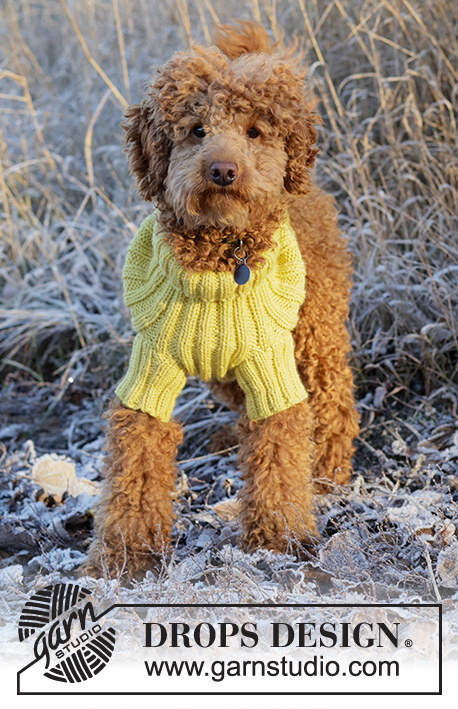
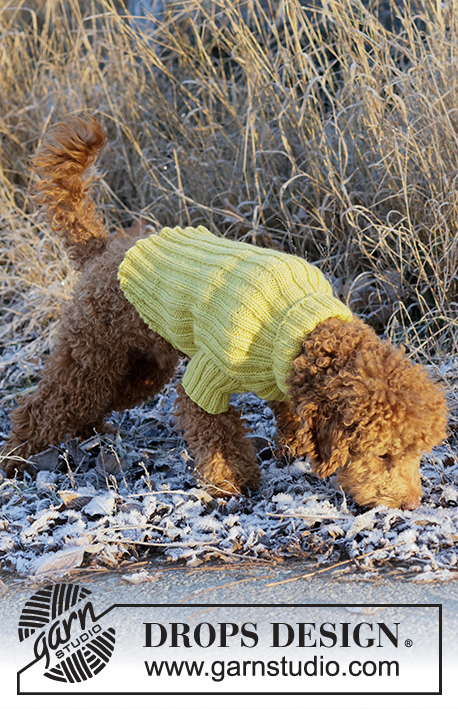
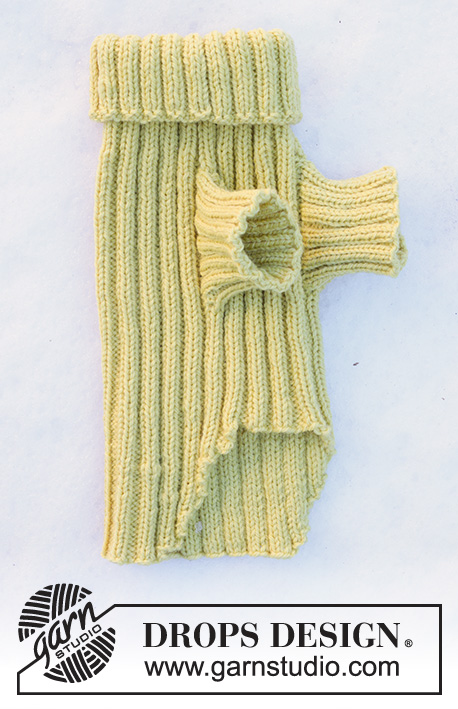


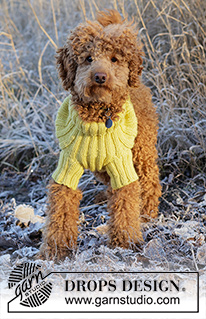

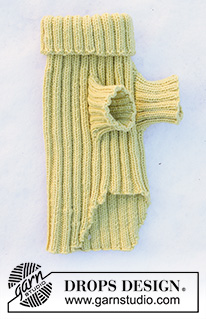




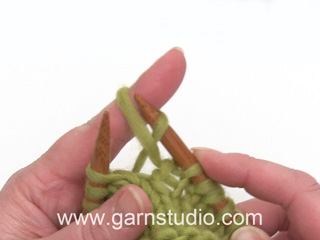



































Comments / Questions (8)
Mir ist es nicht ganz klar, werden die Abnahmen nur in den Hinreihen vorgenommen oder auch in den Rückreihen? Lg
25.01.2024 - 08:38DROPS Design answered:
Liebe Sandra, wenn man am Ende Rumpf abkettet wird man beidseitig abketten, dh am Anfang die Hin- sowie die Rückreihen abketten, damit beide Seiten symmetrisch sind. Viel Spaß beim stricken!
25.01.2024 - 09:25Ik heb een vraag over het minderen van het hondentruitje nummer 228-55 Ik ben een leek in patroon lezen. Als ik gewoon doe wat er staat hou ik 14 steken teveel over. Kunt u uitleggen wat ik fout doe. Ik doe precies wat er staat 2x 2steken 5x1 steek 1x2 steken 1x 3 steken Maar waarschijnlijk lees ik dit verkeerd. Graag ontvang ik hoe ik dit moet lezen. Groetjes Catharina
27.06.2023 - 14:31DROPS Design answered:
Dag Catharina,
Je breit heen en weer en je kant aan beide kanten deze serie steken af, waardoor je 2 keer 14 steken in totaal afkant.
29.06.2023 - 07:11Hallo! Ich würde in den Hundepullover gerne eine Öffnung im Rücken für eine Hundegeschirr einarbeiten. Wie mache ich das am Besten?? Vielen Dank schonmal für die Antwort!
01.12.2022 - 10:49DROPS Design answered:
Liebe Stefanie, leider können wir nicht jede Anleitung nach jeder Anfrage anpassen bzw umrechnen; sicher kann Ihnen aber Ihr DROPS Händler damit auch per Telefon oder per E-Mail weiterhelfen. Bei dem DROPS Workshop können Sie auch gerne andere Strickerinnen mal um Hilfe bitten. Viel Spaß beim stricken!
01.12.2022 - 11:43Hermoso el jersey! Me gustaría que diseñaran uno para Pitbull o Amstaff.
04.06.2022 - 18:48Ville gerne vide hvor meget garn der skal bruges til hundetrøj str. S/m? Kan den opskrift ikke gemmes på jeres side? Hvordan?
28.02.2022 - 18:39DROPS Design answered:
Hej Susanne, du skal bruge 200 g i både størrelse S og M, du finder materialer og selve opskriften her på siden - Du kan klikke på hjertet i højre hjørne eller så gemmer du bare selve adressen på denne opskrift :)
02.03.2022 - 12:10Bonjour, Je cherche des modèles de pull pour mes whippets pour les fois où ils sont sortis en laisse pendant l’hiver. J’ai du mal à adapter l’encolure. Avis aux amateurs: pull pour un fil en 4-5 jaquard norvégien ou gros pull tricoté en 7 avec torsades et nid d’abeille. Nota: les greyhounds sont juste un peu plus grands mais ont les mêmes proportions. Faciles à faire les tours de cou fringants en j. norvégien, salvateurs en fluo en présence de chasseurs.
24.12.2021 - 18:11DROPS Design answered:
Bonjour Tilia, je peux vous proposer nos deux plus grands modèles (en L/type Setter Irlandais): Warm Banjo et Let's Go; en espérant qu'ils soient adaptés à la taille souhaitée. Bon tricot!
03.01.2022 - 08:24Thank you for the reply. But the pattern only states that you cast off at the beginning at each row, rather than both ends? Do you have a video that explains how to cast off at the end of a row? I haven’t done this before. Thanks
19.12.2021 - 19:11DROPS Design answered:
Dear Mrs Edwards, you have to cast off the stitches at the beginning of each side, both from RS and from WS as follows: cast off 2 sts at the beg of next 4 rows (= 2 sts 2 times on each side), then 1 stitch at the beg of next 14 rows (= 1 st 7 times on each side), 2 sts at the beg of next 2 rows (= 2 sts on each side) and 3 sts at the beg of next 3 rows (3 sts on each side) =you cast off: (2 sts 2 times + 1 st 7 times + 2 sts 1 time + 3 sts 1 time) x 2 sides =32 sts; 87-32= 55 sts remain. Happy knitting!
20.12.2021 - 08:22I am confused with the sweater section of this pattern. I am doing the largest size. I have 100 stitches. I have cast off 13. This leaves 87 stitches. You then bind off a total of 16 stitches over the beginning of the next few next rows. The pattern states this should leave you with 55 stitches. I have 71 (87-16) Have I misread the pattern?
18.12.2021 - 19:42DROPS Design answered:
Dear Victoria, you need to decrease on both sides. So you decrease twice the stitches (32 stitches) and there are 55 stitches remaining. Happy knitting!
19.12.2021 - 18:27